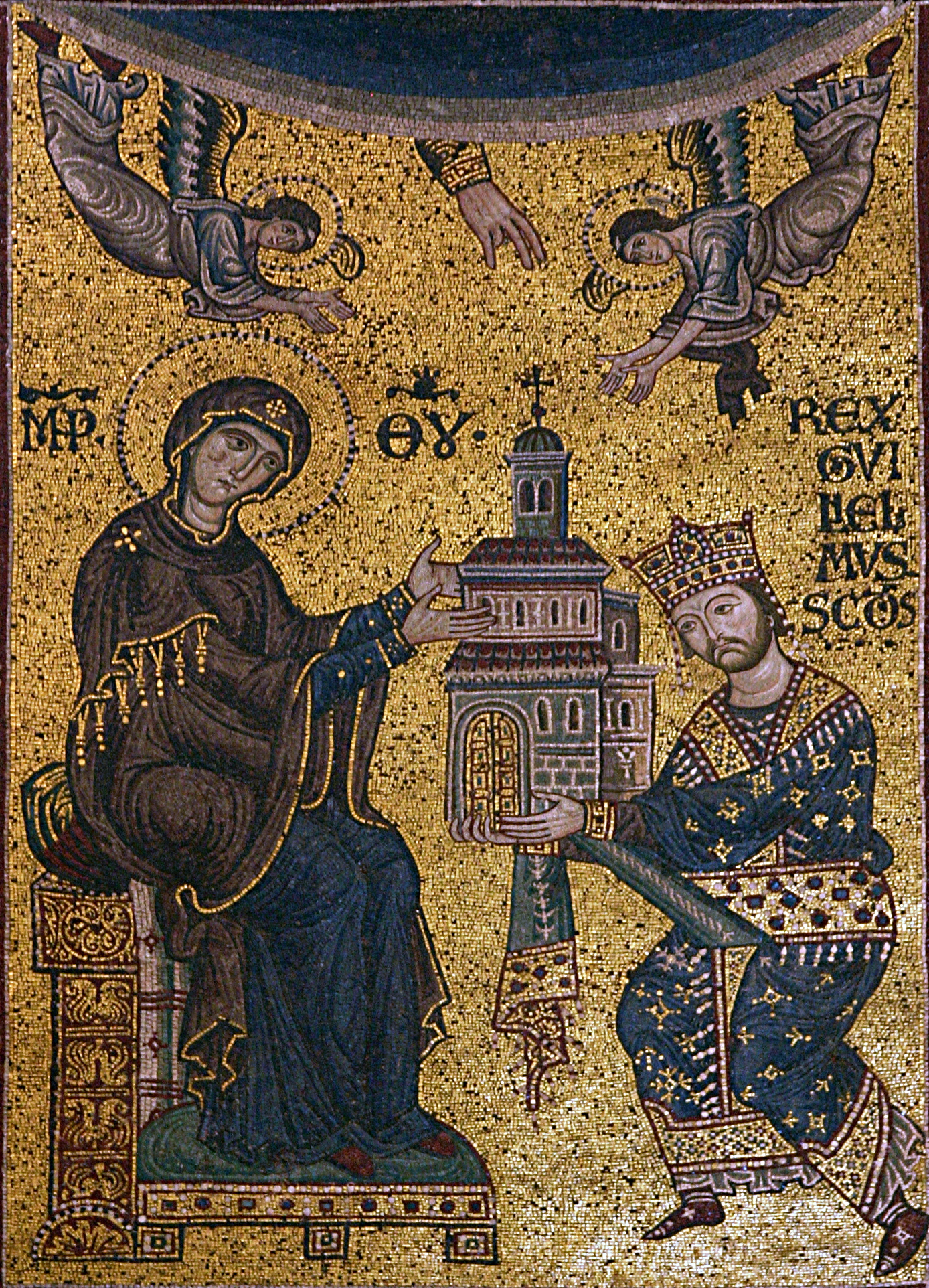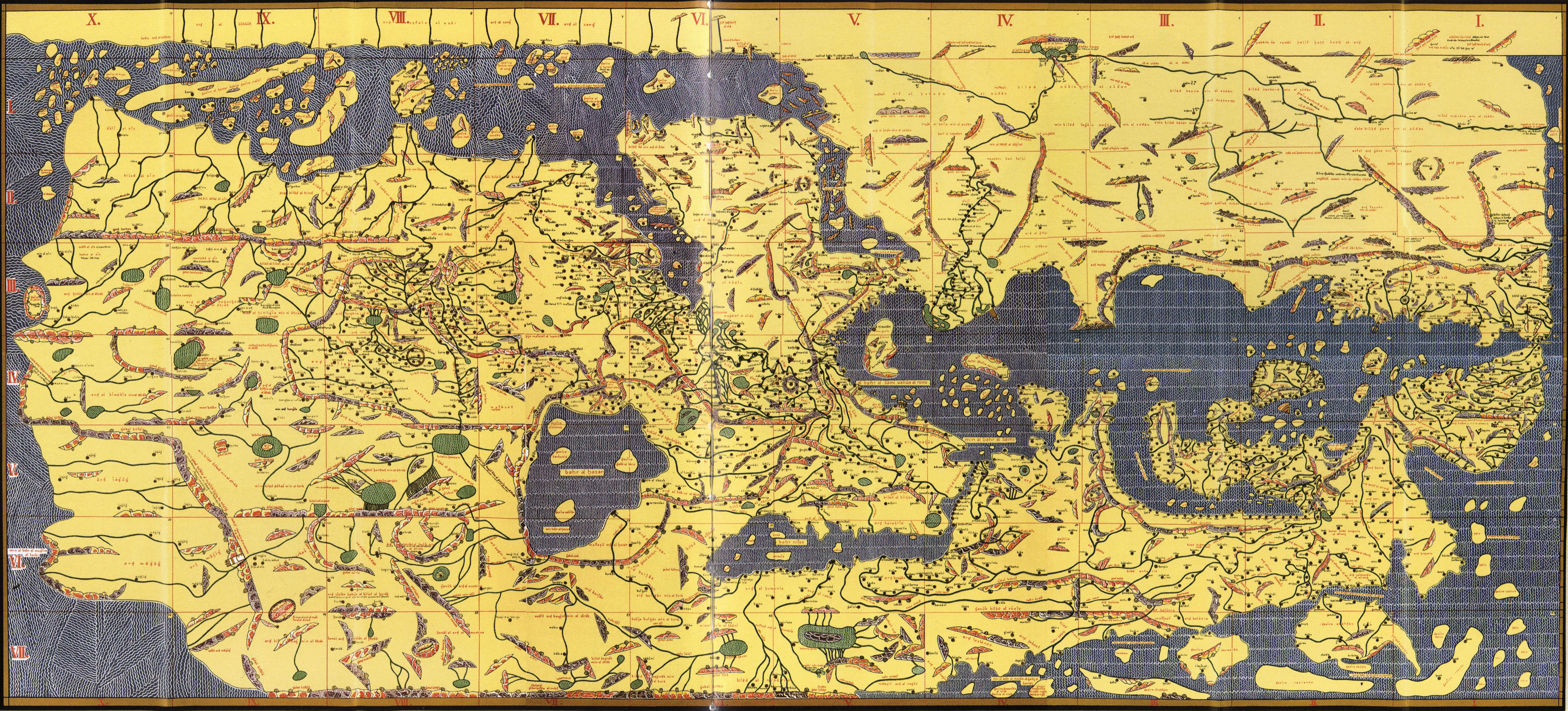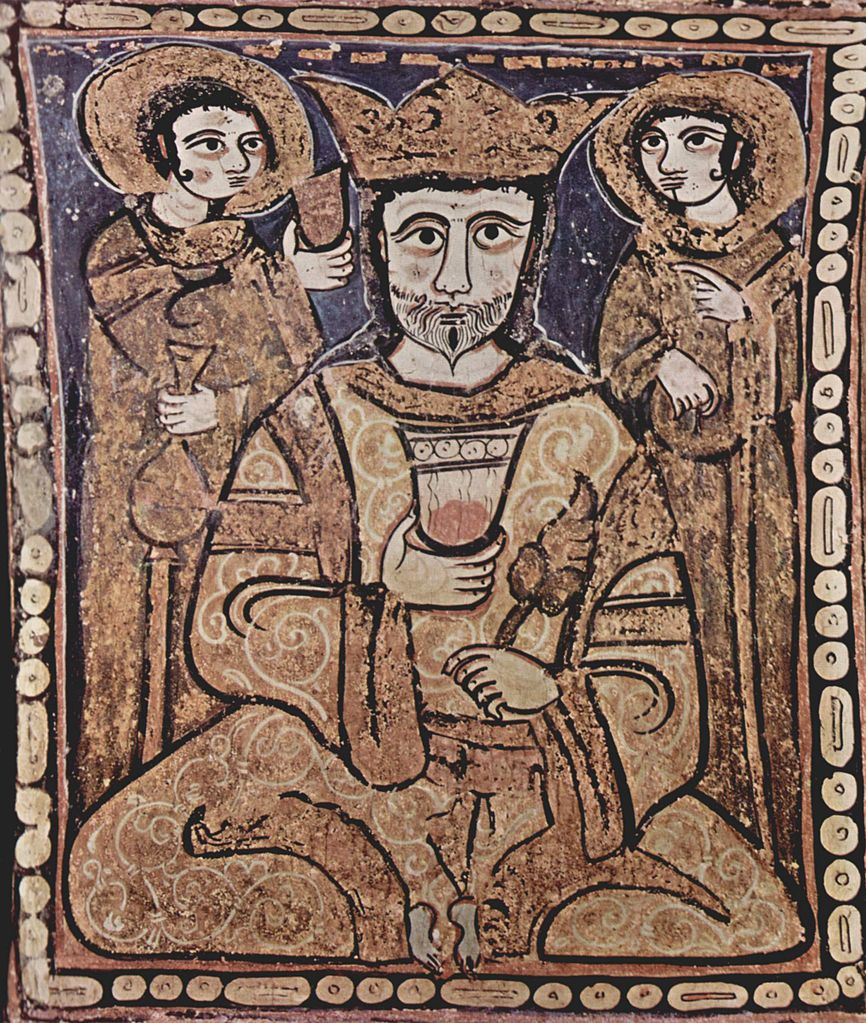3. Norman Sicily: a hybrid civilization?
The creation of a “Norman” kingdom in Sicily did not put an end to the great diversity that prevailed in southern Italy and Sicily. The uniqueness of the kingdom came from the deliberate choice of sovereigns to take anything that was useful, an unprecedented mix of Latin, Greek and Arab elements. Faced with a great religious diversity (Jews, Latin Christians, Byzantine Christians and Muslims), the powers of the Kingdom of Sicily chose tolerance, which contributed to the creation of a unique situation.
King William II dedicates the Cathedral of Monreale to Virgin Mary
The mosaic representing the dedication of the Cathedral reveals a Byzantine influence, both through its technique (mosaic) and theme (the illustration of a model showing the dedicated building). The figures are depicted in a typically Byzantine manner: King William II (1166-1189) is dressed as a Byzantine emperor. Below the figure of Virgin Mary there is a Greek inscription M(ḗtē)r Th(e)ou (Mother of God), which is commonly used in Byzantine Churches. However, below the figure of King William II there is a Latin inscription: Rex Guillelmus s(e)c(und)us (King William II). The use of inscriptions to identify the figures is also typically Byzantine.

Mosaic from the cathedral of Monreale.
Wikimedia Commons. Usable under the conditions of
the GNU Free Documentation License
Photo by José Luiz
Licensed under the
Creative Commons Attribution-Share Alike 4.0 International
Image under URL :
http://commons.wikimedia.org/wiki/File:Dedication_mosaic_-_Cathedral_of_Monreale
(30/03/2015)
Map from the Tabula Rogeriana by Muhammad al-Idrīsī
The Tabula Rogeriana (The Book of Roger), from its Arabic name Nuzhak al-mushtāq fi’khtirāq al-āfāq (“The Book of Pleasant Journeys into Faraway Lands”) is a geographical treatise dating from 1138. The King of Sicily Roger II (1130-1154) commissioned the Arab geographer Muhammad al-Idrīsī (1099-1161), who used his observations from his travels, the knowledge of other travellers, after cross-checking and using only information that he was sure of, and other works by geographers that preceded him. Completed in 1154, just before the death of King Roger II, the volume was intended to describe the world as it was known at the time. Earth is described as a sphere with a circumference of 37,000 km (in reality 40,000 km). The Tabula Rogeriana is known mostly for its world map (the map shows the North at the bottom), which was considered one of the most precise maps until the emergence of Portulan charts at the end of the 13th century.

Collage of the images from the Bodleian MS Pococke 375 (copy of 1480).
Wikimedia Commons. Usable under the conditions of
the GNU Free Documentation License
Public domain
Image under URL:
http://commons.wikimedia.org/wiki/File:TabulaRogeriana.jpg
(30/03/2015)
King Roger II in Arab dress
The representation of King Roger II is from the muqarnas in the Palatin Chapel of Palermo. As its name suggests, the Chapel was part of the royal palace and its construction was commissioned by King Roger II in 1132. It is inspired from Byzantine architecture (church with a dome), but the decoration is more varied: the mosaics, which are also inspired from Byzantium, are alongside Islamic motifs from the muqarnas. King Roger II is shown in Arab dress and the overall style is reminiscent of the portraits of caliphs.

Ceiling of the Palatine Chapel (Palermo).
Wikimedia Commons. Usable under the conditions of
the GNU Free Documentation License
Public domain
Image under URL:
http://commons.wikimedia.org/wiki/File:Arabischer_Maler_der_Palastkapelle
(30/03/2015)
Roger II in Byzantine dress
The Church of Martorana, or more exactly Santa Maria dell'Ammiraglio (St. Mary of the Admiral), was founded by George of Antioch, who was principal minister of Roger II and received the title of admiral in 1143. It was built to celebrate Byzantine liturgy and respect the tradition of Byzantine churches, including the dome and the Greek cross-plan. Today it is used by the Italo-Albanian Greek Catholic Church, one of the Eastern churches, which is in communion with the Pope in Rome and the Catholic Church, but follows the rituals of the Orthodox liturgy.
The mosaic shows Roger II in a typically Byzantine stance dressed like a Byzantine emperor, receiving the crown from Christ, a classic theme of Byzantine mosaics. The inscription is in Greek: Rogerios rḗx (Roger roi) and I(ēsou)s Ch(ristó)s (Jesus Christ). Rḗx was borrowed from Latin to refer to kings, since basileús, which originally meant “king”, was reserved for the emperor.

Wikimedia Commons. Usable under the conditions of the GNU Free Documentation License
Photo by Matthias Süßen
Licensed under the
Creative Commons Attribution-Share Alike 2.5 Generic
Image under URL :
http://commons.wikimedia.org/wiki/File:Martorana_RogerII2008.jpg
(30/03/2015)






